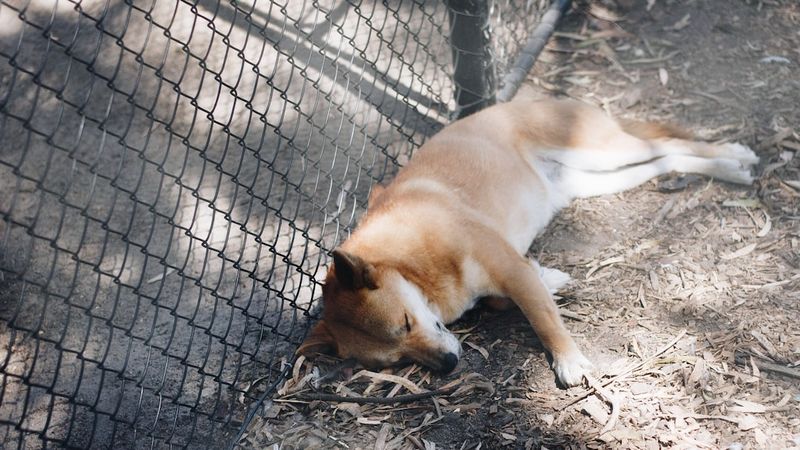Dingoes Pose a Threat to Sunbathers on Australian Beach
June 4, 2023 – A recent string of dingo attacks on sunbathers and campers on the island of K’gari (Fraser Island) has prompted authorities to issue a warning to beachgoers in Queensland, Australia. These incidents have reignited the ongoing debate about the coexistence of humans and wildlife in natural habitats, raising questions about the responsibility of both tourists and local authorities in ensuring the safety of all parties involved.
Recent Attacks
The alarming footage captured by the Queensland Department of Environment and Science shows a dingo approaching a group of sunbathers and biting a French tourist’s rear end. In another video, a dingo is seen chasing a boy and a man down the beach. These incidents highlight the increasing boldness and aggression of the wild dogs, which have previously been known to scavenge for food and maintain a distance from human activity.
Unfortunately, this particular dingo was responsible for multiple attacks. Prior to biting the sunbathing woman, it attacked and bit a 7-year-old boy a few days earlier. The severity of these incidents led authorities to make the difficult decision to euthanize the dingo on June 10, citing its negative and “high risk” interactions with humans.
Only a week after this incident, another dingo grabbed a 10-year-old boy by the shoulder near a campsite and dragged him underwater. The boy was saved by his brave 12-year-old sister, but he sustained puncture wounds, scratches, and bruises in the process. The same dingo remained in the area, foraging for buried food scraps and exhibiting behavior indicative of a loss of natural wariness toward humans.
The Coexistence Dilemma
These recent dingo attacks and confrontations raise important questions about wildlife management and peaceful coexistence. Fraser Island is a UNESCO World Heritage site and renowned for its unique ecosystem, including its dingo population. The challenge lies in finding a balance between preserving the island’s natural habitat and safeguarding the well-being of visitors and residents.
Dingoes play a crucial role in maintaining the island’s ecosystem, acting as top predators and helping control other species’ populations. However, as these incidents illustrate, there are some individuals within the dingo population that have become habituated to human presence and have lost their fear of humans. This leads to dangerous situations where they may become aggressive in their quest for food.
Visitor Responsibility
While the responsibility for ensuring safety lies with both visitors and local authorities, there are several measures that tourists can take to reduce the risk of dingo encounters:
- Always stay close to children: It is imperative to keep children and young teenagers within arm’s reach to minimize the chances of dingo attacks.
- Travel in groups: Walking in groups can act as a deterrent for dingoes and reduce the likelihood of confrontations.
- Choose fenced camping areas: Opting for camping areas that are fenced can provide an added level of protection from dingoes.
- Avoid running or jogging: Sudden movements, such as running or jogging, can trigger negative dingo interactions. It is advisable to maintain a calm and steady pace.
- Do not feed dingoes: Feeding dingoes can lead to dependency and habituation, increasing the risk of aggressive behavior. It is essential to resist the temptation to feed these wild animals.
- Safeguard food and rubbish: Locking up food stores, iceboxes, and securing all rubbish, fish, and bait helps reduce the likelihood of attracting dingoes to camping areas.
Conclusion
Dingo attacks on sunbathers and campers on Fraser Island serve as a reminder that wildlife tourism comes with inherent risks. As tourists flock to coastal areas and other wildlife-rich destinations, it is essential to balance the preservation of natural habitats with public safety. Local authorities and wildlife conservation organizations must work together to implement effective management strategies that ensure the coexistence of humans and wildlife in harmony.
By adhering to the guidelines provided by the Queensland government, visitors can minimize the risk of dingo encounters and contribute to the long-term conservation of these magnificent animals. It is crucial that all stakeholders remain vigilant and proactive in promoting responsible tourism practices to protect both visitors and wildlife.

<< photo by Y S >>
The image is for illustrative purposes only and does not depict the actual situation.
You might want to read !
- When Dingoes Attack: A Shocking Encounter on an Australian Beach
- Underwater Disaster: Catastrophic Implosion Strikes Titanic Tourist Sub
- SHEIN’s Reality Show: Unveiling the Fashionable Side of Saudi Arabia
- Succession’s Sarah Snook to Illuminate West End Stage in Dorian Gray Revival
- “Boundless Talent: Sarah Snook Takes on a Theatrical Feat with 26 Characters”




